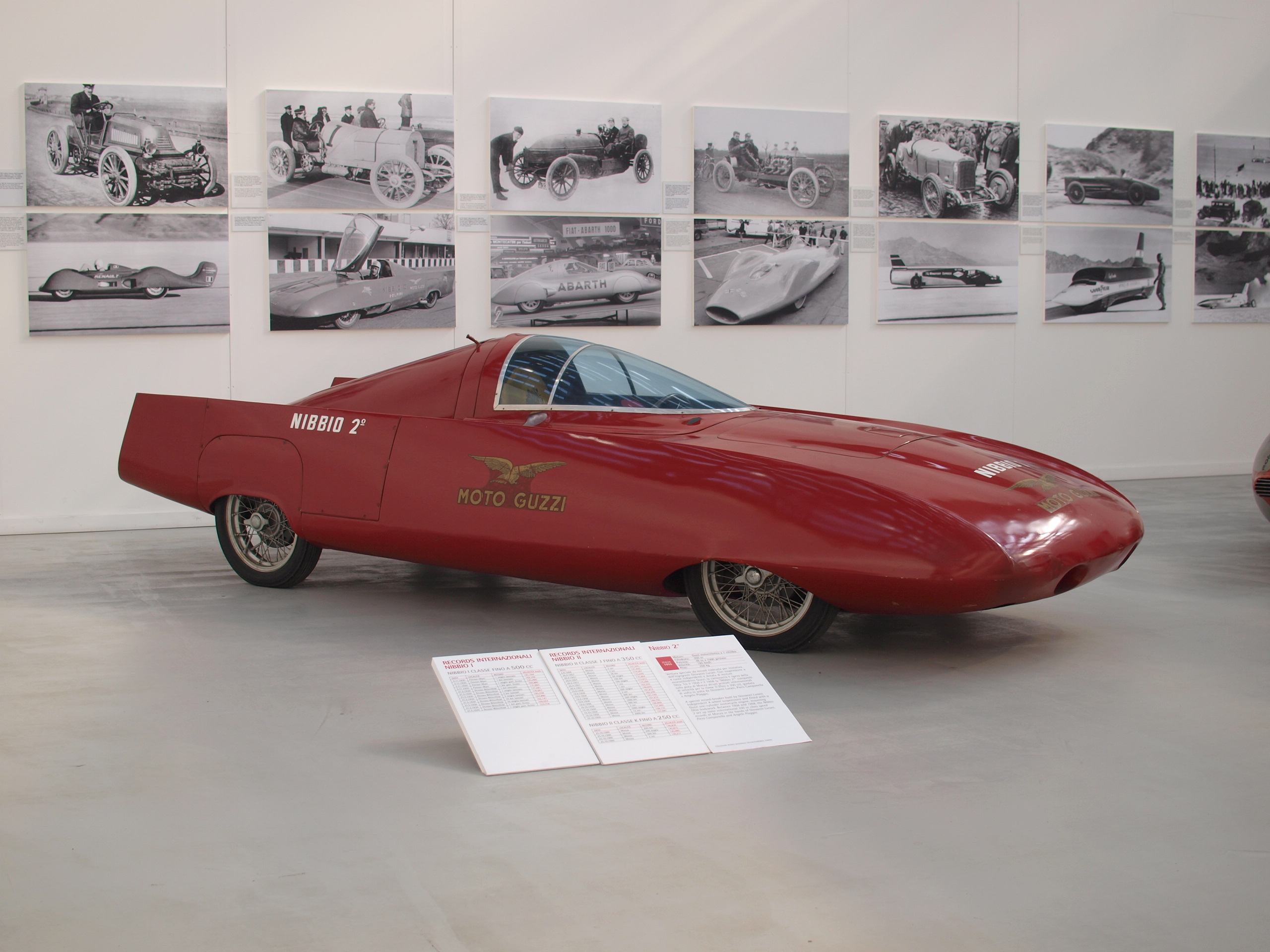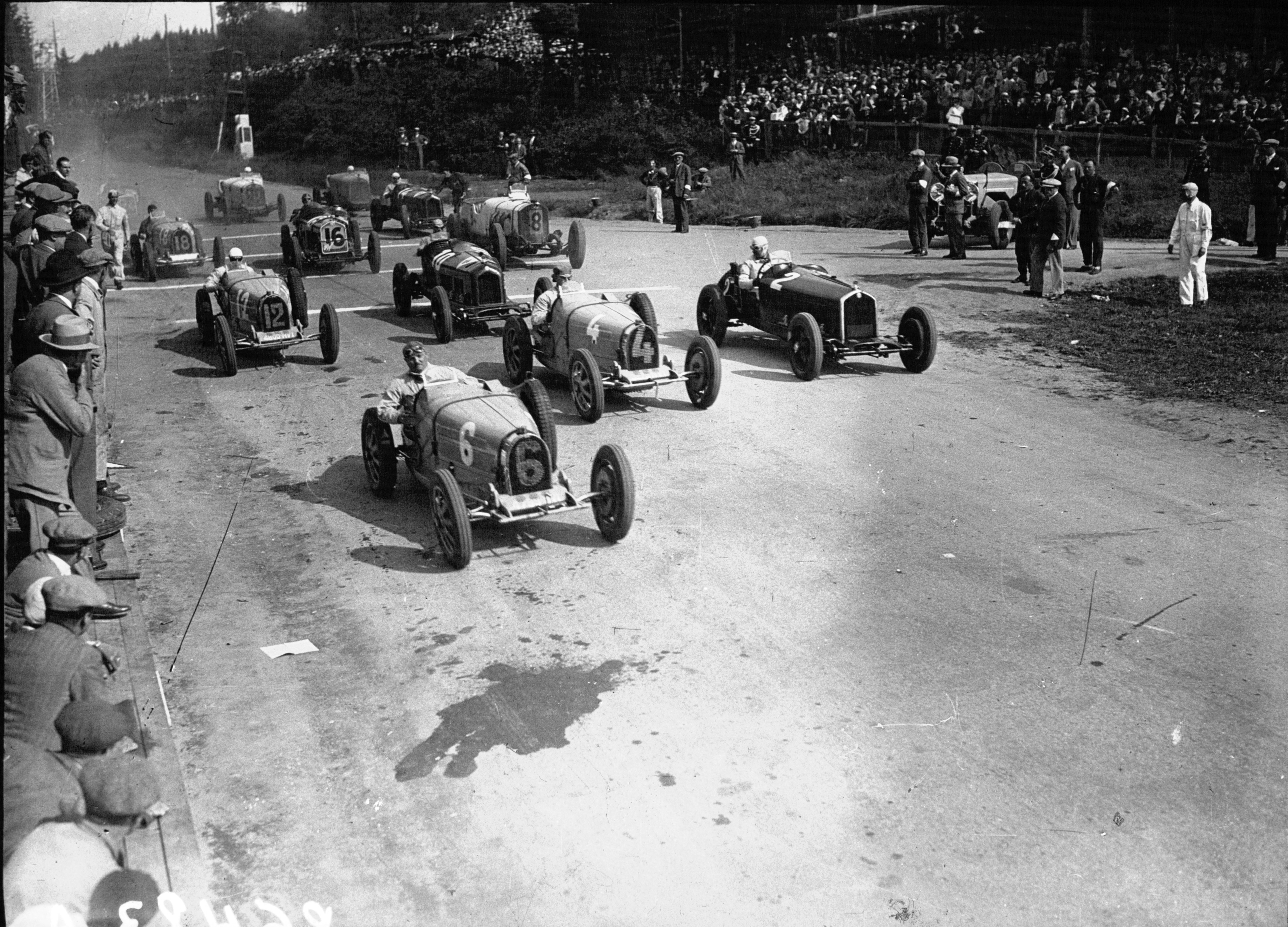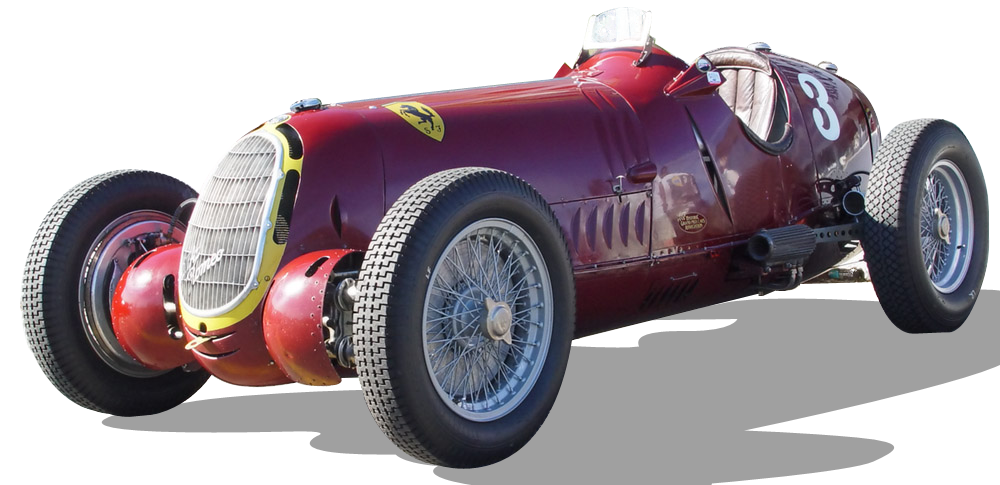|
Giovanni Lurani
Giovanni “Johnny” Lurani Cernuschi, VIII Count of Calvenzano (December 19, 1905 – January 17, 1995) was an Italian automobile engineer, racing car driver and journalist. He studied engineering at the Politecnico di Milano and raced cars such as Salmson, Derby, Alfa Romeo and Maserati, participating eleven times in the Mille Miglia. Lurani took class wins in the event three times: 1933 in an MG K3, 1948 in a Healey and 1952 in a Porsche. After partaking in the second Italo-Abyssinian War from 1935 to 1936, Lurani founded the racing team Scuderia Ambrosiana in 1937 along with Luigi Villoresi and Franco Cortese (1937). Sustaining a bad hip injury in a Maserati 4CM at Crystal Palace, Lurani ended his single-seater career in 1938 but continued racing sportscars until 1953. After World War II Lurani became more involved in administration and politics, working with the FIA, where he initiated GT in 1949 and Formula Junior in 1959. He also designed record breaking cars based on ... [...More Info...] [...Related Items...] OR: [Wikipedia] [Google] [Baidu] |
1935 Nibbio 1 Giovanni Lurani
Events January * January 7 – Italian premier Benito Mussolini and French Foreign Minister Pierre Laval conclude an agreement, in which each power agrees not to oppose the other's colonial claims. * January 12 – Amelia Earhart becomes the first person to successfully complete a solo flight from Hawaii to California, a distance of 2,408 miles. * January 13 – A plebiscite in the Territory of the Saar Basin shows that 90.3% of those voting wish to join Germany. * January 24 – The first canned beer is sold in Richmond, Virginia, United States, by Gottfried Krueger Brewing Company. February * February 6 – Parker Brothers begins selling the board game Monopoly in the United States. * February 13 – Richard Hauptmann is convicted and sentenced to death for the kidnapping and murder of Charles Lindbergh Jr. in the United States. * February 15 – The discovery and clinical development of Prontosil, the first broadly effective antibiotic, is published in a series ... [...More Info...] [...Related Items...] OR: [Wikipedia] [Google] [Baidu] |
Grand Touring
A grand tourer (GT) is a type of car that is designed for high speed and long-distance driving, due to a combination of performance and luxury attributes. The most common format is a front-engine, rear-wheel-drive two-door coupé with either a two-seat or a 2+2 arrangement. Grand tourers are most often the coupé derivative of luxury saloons or sedans. The term is a near-calque from the Italian language phrase ''gran turismo'' which became popular in the English language from the 1950s, evolving from fast touring cars and streamlined closed sports cars during the 1930s. Origin in Europe The grand touring car concept originated in Europe in the early 1950s, especially with the 1951 introduction of the Lancia Aurelia B20 GT, and features notable luminaries of Italian automotive history such as Vittorio Jano, Enzo Ferrari and Johnny Lurani. Motorsports became important in the evolution of the grand touring concept, and grand touring entries are important in endurance sports- ... [...More Info...] [...Related Items...] OR: [Wikipedia] [Google] [Baidu] |
1951 24 Hours Of Le Mans
The 1951 24 Hours of Le Mans was the 19th Grand Prix of Endurance, and took place on 23 and 24 June 1951. It was won by Peter Walker and Peter Whitehead in their works-entered Jaguar C-type, the first Le Mans win for the marque. The arrival of Jaguar's and Cunningham's first purpose-built racers in direct competition with Ferrari, and the first showing for Porsche and Lancia, marked the beginning of an era of intense competition between manufacturers of sports cars. The more powerful new sport racers would develop rapidly and put a final end to luxury touring cars and their derivatives as top contenders at Le Mans. It was the final outing for Delahaye and Bentley (for 50 years) and the sports prototype tide would overwhelm Talbot-Lago in the next couple of years. The race was marred by the death of French driver Jean Larivière within the opening laps of the race. Regulations This year there were no significant changes to the regulations, by either the CSI or the Automobile Club ... [...More Info...] [...Related Items...] OR: [Wikipedia] [Google] [Baidu] |
1931 Belgian Grand Prix
The 1931 Belgian Grand Prix was a Grand Prix motor race held at Spa-Francorchamps on 12 July 1931. Classification Race Starting grid positions Notes References Belgian Grand Prix Belgian Grand Prix The Belgian Grand Prix (French: ''Grand Prix de Belgique''; Dutch: ''Grote Prijs van België''; German: ''Großer Preis von Belgien'') is a motor racing event which forms part of the Formula One World Championship. The first national race of ... Grand Prix, 1931 {{belgium-stub ... [...More Info...] [...Related Items...] OR: [Wikipedia] [Google] [Baidu] |
1931 French Grand Prix
The 1931 French Grand Prix (formally the XXV Grand Prix de l'A.C.F.) was a Grand Prix motor race held at Autodrome de Linas-Montlhéry on 21 June 1931. As with the other two races in the 1931 AIACR European Championship, this race was held over 10 hours, not over a fixed distance. As a result, most cars had two drivers. The race was won by Louis Chiron and Achille Varzi driving a factory entered Bugatti T51, who after early race battles lead more than eight hours of the race Classification Notes References French Grand Prix French Grand Prix The French Grand Prix (french: Grand Prix de France), formerly known as the Grand Prix de l'ACF (Automobile Club de France), is an auto race held as part of the Fédération Internationale de l'Automobile's annual Formula One World Championsh ... 1931 in French motorsport {{France-sport-stub ... [...More Info...] [...Related Items...] OR: [Wikipedia] [Google] [Baidu] |
1931 Italian Grand Prix
The 1931 Italian Grand Prix was a Grand Prix motor race held at Monza on 24 May 1931. The race was the first of three Grands Prix that were part of the inaugural European Championship. The Alfa Romeo works team pairing of Giuseppe Campari and Tazio Nuvolari won the race, ahead of their teammates Ferdinando Minoia and Baconin Borzacchini in second, while third place went to the works Bugattis of Albert Divo and Guy Bouriat. Entries : — Luigi Arcangeli was originally designated as Campari's co-driver in car #26, but he was replaced by Marinoni after he was killed during practice. Starting grid Grid positions were allocated by drawing lots. Classification : — Nuvolari and Borzacchini did not receive the points for first and second place, respectively, because they were not driving in their designated cars. The seven points apiece that they received were for driving car #28, which completed less than a quarter of the race distance. Attilio Marinoni and Goffredo Zehe ... [...More Info...] [...Related Items...] OR: [Wikipedia] [Google] [Baidu] |
Straight-six Engine
The straight-six engine (also referred to as an inline-six engine; abbreviated I6 or L6) is a piston engine with six cylinders arranged in a straight line along the crankshaft. A straight-six engine has perfect primary and secondary engine balance, resulting in fewer vibrations than other designs of six or less cylinders. Until the mid-20th century, the straight-six layout was the most common design for engines with six cylinders. However, V6 engines became more common from the 1960s and by the 2000s most straight-six engines had been replaced by V6 engines. An exception to this trend is BMW which has produced automotive straight-six engines from 1933 to the present day. Characteristics In terms of packaging, straight-six engines are almost always narrower than a V6 engine or V8 engine, but longer than straight-four engines, V6s, and most V8s. Straight-six engines are typically produced in displacements ranging from , however engines ranging in size from the Benelli 750 ... [...More Info...] [...Related Items...] OR: [Wikipedia] [Google] [Baidu] |
Alfa Romeo In Motorsport
During its history, Alfa Romeo has competed successfully in many different categories of motorsport, including Grand Prix motor racing, Formula One, sportscar racing, touring car racing and Rallying, rallies. They have competed both as a constructor and an engine supplier, via works entries (usually under the name Alfa Corse or Autodelta) and private entries. The first racing car was made in 1913, three years after the foundation of A.L.F.A., the ALFA 40/60 HP, 40/60 HP had 6-litre straight-4 engine. Alfa Romeo quickly gained a good name in motorsport and gave a sporty image to the whole marque. Pre-war Early history Alfa Romeo started motor racing almost immediately after it was founded. A.L.F.A. ventured into motor racing in 1911, with drivers Franchini and Ronzoni competing in the Targa Florio with two ALFA 24 HP, 24 HP models. The marque's first success came in 1913 when Nino Franchini finished second in the Parma-Poggio Berceto race with a ALFA 40/60 HP, 40/60 HP. Giuseppe ... [...More Info...] [...Related Items...] OR: [Wikipedia] [Google] [Baidu] |
1931 Grand Prix Season
The 1931 Grand Prix season was a watershed year, with the advent of the AIACR European Championship. After several years of Grand Prix racing in the doldrums with little technical development, 1931 saw new models come from all three main manufacturers: Bugatti, Maserati and Alfa Romeo. The AIACR regulations were to Formula Libre (open formula) rules for the cars, but the race-format chosen was to run the Grands Prix over a marathon ten hours each with two drivers per car. The pair had to be the same for all three races otherwise only the lead driver would score points. The championship was won by Ferdinando Minoia, driving for the Alfa Corse works team. He was tied on points with his team-mate Giuseppe Campari after the three races. Despite not having won any of the races, his consistency gave him the tiebreaker by covering a greater distance across the combined 30 hours of racing. However, the endurance format of the series was exhausting and unpopular with the drivers, and ... [...More Info...] [...Related Items...] OR: [Wikipedia] [Google] [Baidu] |
Tazio Nuvolari
Tazio Giorgio Nuvolari (; 16 November 1892 – 11 August 1953) was an Italian racing driver. He first raced motorcycles and then concentrated on sports cars and single-seaters. A resident of Mantua, he was known as 'Il Mantovano Volante' (The Flying Mantuan) and nicknamed 'Nivola'. His victories—72 major races, 150 in all—included 24 Grands Prix, five Coppa Cianos, two Mille Miglias, two Targa Florios, two RAC Tourist Trophies, a Le Mans 24-hour race, and a European Championship in Grand Prix racing. Ferdinand Porsche called him "the greatest driver of the past, the present, and the future." Biography Nuvolari started racing motorcycles in 1920 at the age of 27, winning the 1925 350cc European Championship. Having raced cars as well as motorcycles from 1925 until 1930, he then concentrated on cars, and won the 1932 European Championship with the Alfa Romeo factory team, Alfa Corse. After Alfa Romeo officially withdrew from Grand Prix racing Nuvolari drove for Enzo F ... [...More Info...] [...Related Items...] OR: [Wikipedia] [Google] [Baidu] |
Premio Bancarella
The Premio Bancarella is an Italian literary prize established in 1953; it is given in Pontremoli Pontremoli (; local egl, Pontrémal; la, Apua) is a small city, ''comune'' former Latin Catholic bishopric in the province of Massa and Carrara, Tuscany region, central Italy. Literally translated, Pontremoli means "Trembling Bridge" (from ''pon ... every year, the last Saturday or the last Sunday in July. At first, six books are selected and award the ''Premio Selezione Bancarella'', then the booksellers establish the winner with their vote. The awarding of the prize take place in the last evening. At present, Premio Bancarella is at the 54th edition. List of winners Premio Bancarella della Cucina The Premio Bancarella della Cucina, inaugurated in 2006, is awarded by the Fondazione Città del Libro together with the Accademia Italiana della Cucina and is intended to promote the gastronomic traditions and heritage of Italy., [...More Info...] [...Related Items...] OR: [Wikipedia] [Google] [Baidu] |








